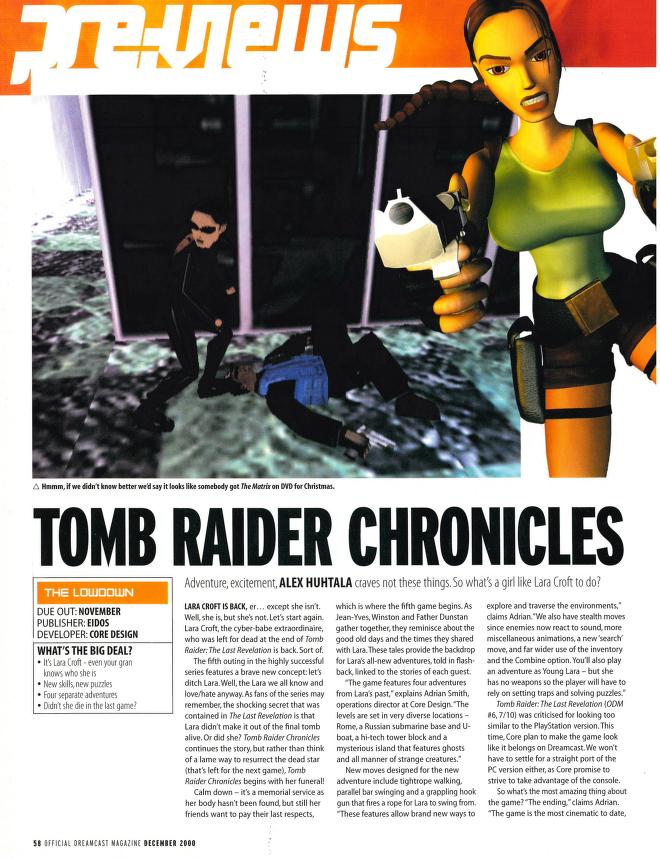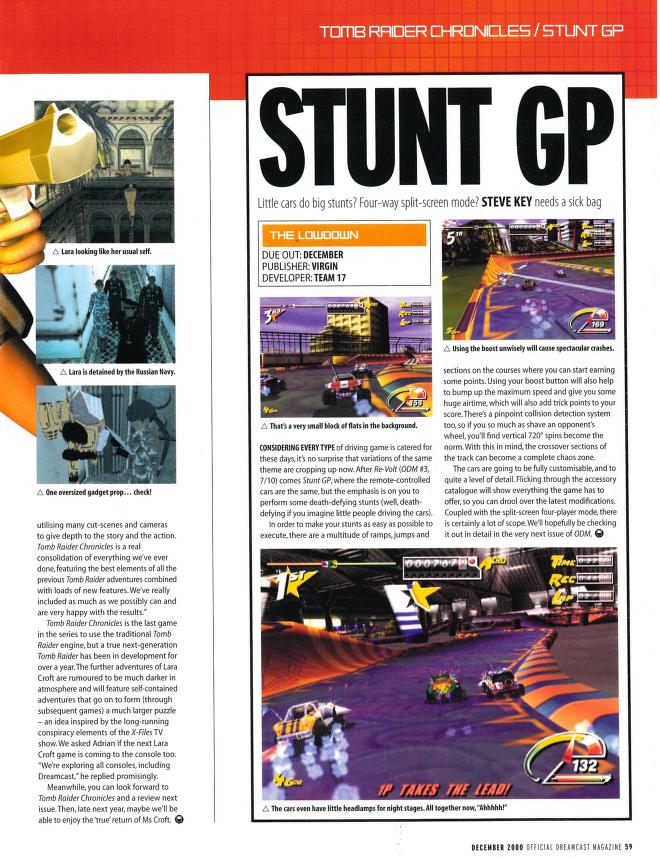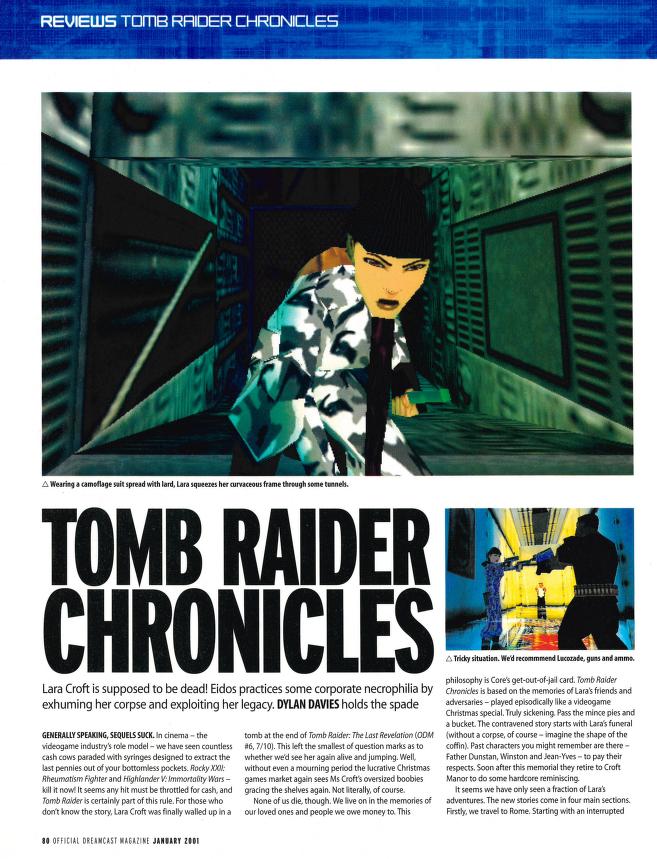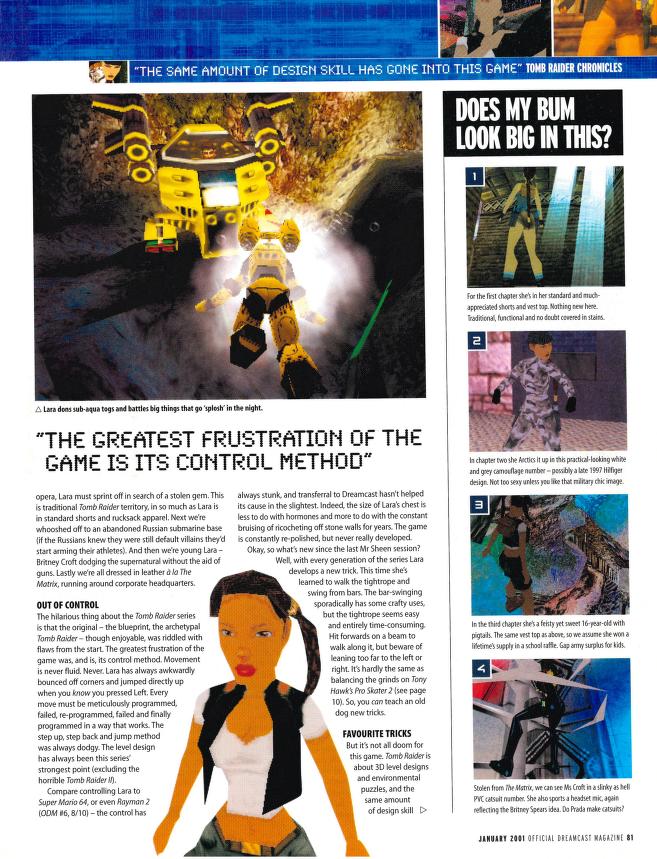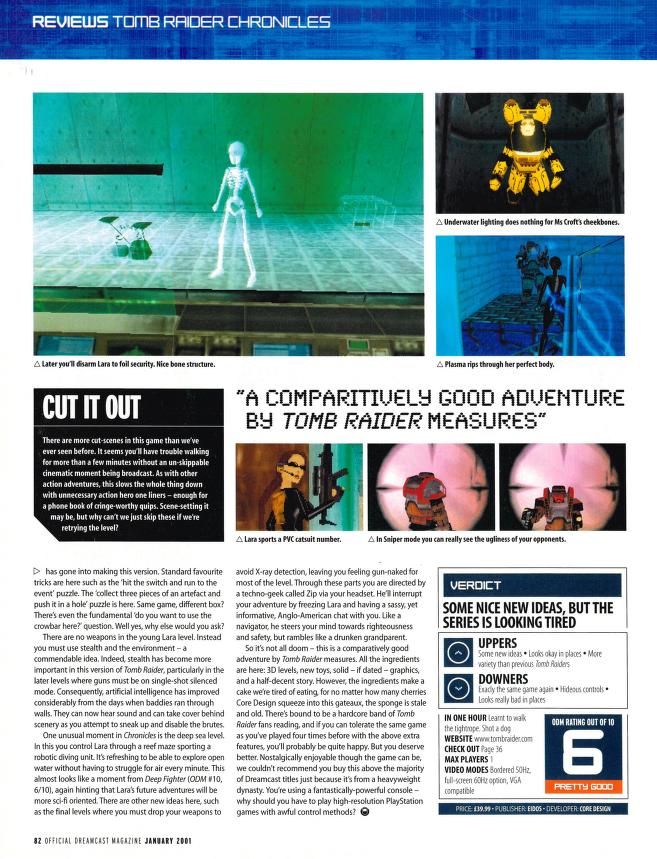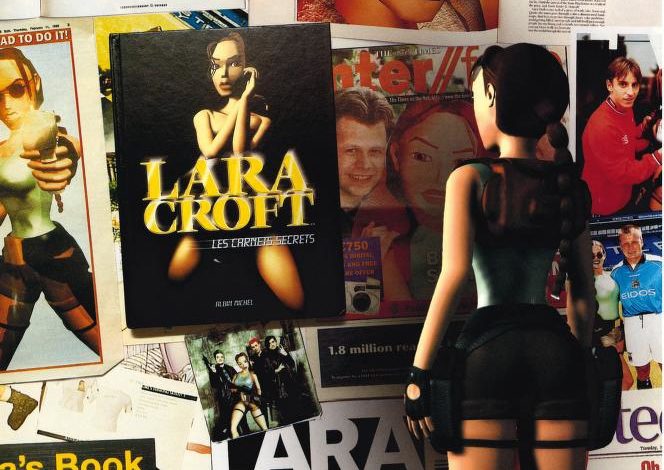
Tomb Raider and Lara Croft’s chronicles on print media – Part 3
Memories, Endings
Despite Smith’s wavering commitment to the console, the fifth game in the franchise, Chronicles, was ultimately confirmed for the Dreamcast. In ODM #14, the game was previewed with both fanfare and skepticism. On one hand, it was nice to see Core Design commit more games to SEGA’s console. On the other, fans felt slightly let down that Tomb Raider IV on the Dreamcast had been such a half-baked port. Optimistically, the preview stated, “This time, Core plan to make the game look like it belongs on Dreamcast.”[1] It seemed Core Design wasn’t deaf to fans’ complaints; however, it would soon become evident they didn’t have time to care about them either.
In the ODM preview, Smith hyped Chronicles to be the most cinematic game in the series to date. While the promise of improved visuals and more cinematic gameplay sounded good, writer Alex Huhtala did press him as to when we would see that true next generation Tomb Raider Core Design had been talking about. Smith coyly stated they were looking at the Dreamcast for the next title, but wouldn’t commit.[2]
In fact, another exclusivity deal with Sony was in the works, and the Dreamcast would have left store shelves long before the game’s (The Angel of Darkness) development was complete. Chronicles was not only the final game Core Design would build in the classic engine, but it would be the final Tomb Raider game fans would get to play on SEGA hardware.
The game was reviewed in the next issue of ODM, scoring 6/10. Though ODM dedicated three pages to the review, and snuck in plenty of fanfare regarding Croft’s history (fitting, amid the game’s funeral setting), writer Dylan Davies was blunt in his criticism. While Tomb Raider IV had been reviewed in light of it being a five-month-old game on 32-bit hardware ported to a much more powerful machine, the fact that Chronicles was less optimized for the Dreamcast than its predecessor broke even the most dedicated of fan’s trust. This was not a game that looked like it belonged on the console, despite Smith’s earlier claims. What was speculated to be a cash grab from the get-go was all but confirmed by the Dreamcast version’s haphazard port, Davies stating, “Eidos practices some corporate necrophilia by exhuming her corpse and exploiting her legacy.”[3]
The game’s stiff and regimented tank controls, previously acknowledged as old-fashioned, were now openly called out as being dated. Davies compared Chronicles to Rayman 2, highlighting the clear evolution 3D platformers had taken since 1996.[4] He continued, “The game is constantly repolished, but never really developed.”[5]
Curiously, Davies even criticized the game’s cutaways – a point Smith had tried to sell in ODM #14. Davies thought the constant cutaways took away from the feeling of solitude the series was so renowned for. He ended with the scathing, but honest:
All the ingredients are here: 3D levels, new toys, solid – if dated – graphics, and a half-decent story. However, the ingredients make a cake we’re tired of eating, for no matter how many cherries Core Design squeeze into this gateaux, the sponge is stale and old. There’s bound to be a band of hardcore Tomb Raider fans reading, and if you can tolerate the same game as you’ve played four times before with the above extra features, you’ll probably be quite happy. But you deserve better. Nostalgically enjoyable as the game can be, we couldn’t recommend you buy this above the majority of Dreamcast titles just because it’s from a heavyweight dynasty. You’re using a fantastically-powered console – why should you have to play high-resolution PlayStation games with awful control methods?[6]
Over at ODCM, they gave the (then) upcoming movie some ink in issue #12, stating the trailer was worth a watch.[7] Their review of Chronicles, however, mirrored ODM’s, though was less forgiving. James Majnero rated it a 4/10, stating, “It’s a great concept – but it’s a wasted one, once you’ve noticed that the game’s stale graphics look so far past their sell-by date, it almost hurts.”[8] Majnero echoed Davies’ criticism about the cutaways, stating the game wasn’t as suspenseful as the original.
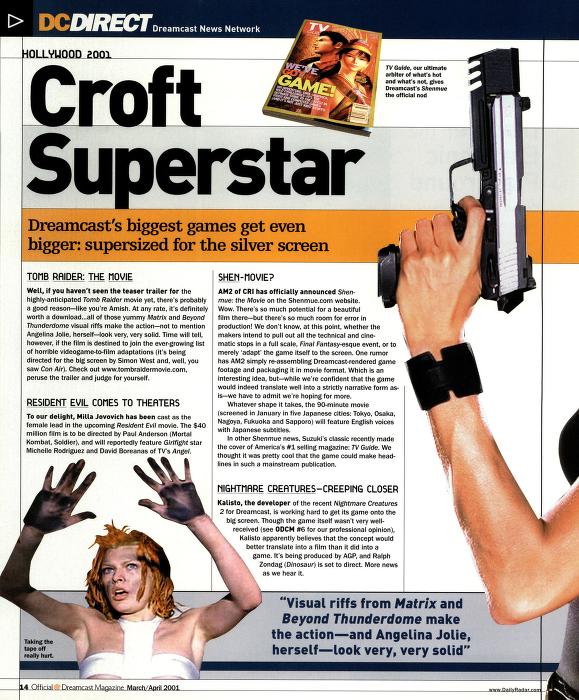
Chronicles may have departed slightly from its predecessors’ design, however, it was still built in the same engine. A distinct lack of vehicle segments was another disappointing omission, and new features like stealth and tightrope walking were gimmicky at best. The return to a linear level structure after the open and expansive Tomb Raider IV also split fans, though for the most part, this was still just regular old Tomb Raider. Again. It is the most unremarkable entry in the series, and on SEGA hardware at that, not benefitting from any special treatment. This was just Croft, hurled out the door for one last adventure.
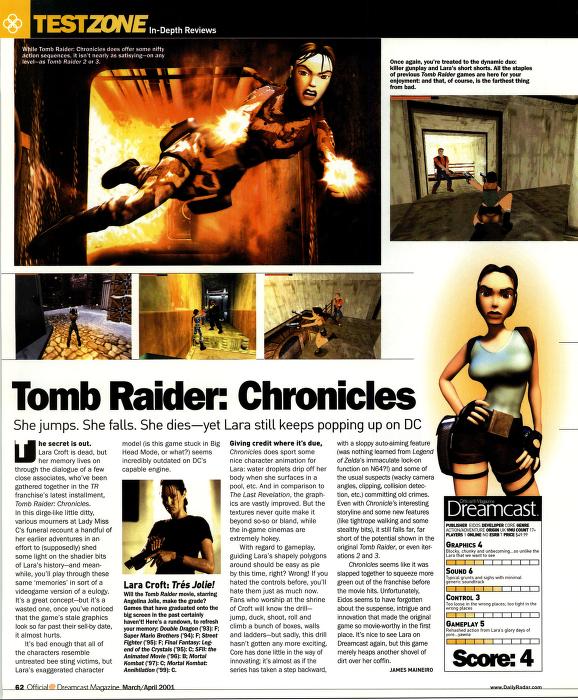
Tomb Raider Burial
SEGA fans saw Croft from her humble beginnings through to her untimely death, but they did not get to relish in Lara-Mania as PlayStation and PC gamers had. Whether or not Tomb Raider II could have run on the Saturn is up for debate, and one can only speculate as to how good Tomb Raider IV and V could have looked if they had been built to take advantage of the Dreamcast’s power. Point is, Eidos decided they just didn’t care enough to try. It’s a stark, but understandable, truth. There just weren’t as many SEGA consoles out there as PlayStations and PCs, so why put the effort into making the game better for such a small audience? Far from the days of Thunderhawk and Skelton Krew, Tomb Raider was an afterthought on SEGA hardware.
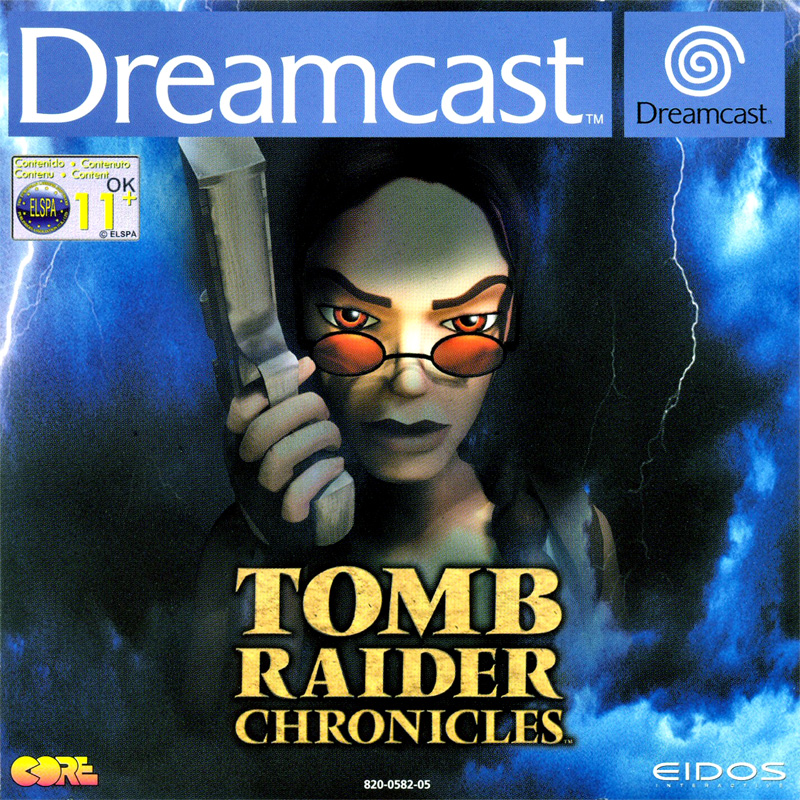
One of the most interesting points in reading the press’ treatment of Croft and Tomb Raider over the years is the vocabulary. This was a time when the gamer demographic was thought to be, erm, homogenous – and that may very well have been the case with the original Tomb Raider, though judging by the mix of fans, it couldn’t have been the norm for long. Despite her somewhat sexualized appearance in renders and promotional items, Croft was never objectified in-game. Still, the fact that she was a woman was pointed out by the press near constantly, with quotes like, “Eidos and Sega, sittin’ in a tree… Here comes Lara on your DC”[1], or “Tom Guise is giving away the bride,”[2] . Croft was often pushed as a digital girlfriend or property.
Like Coupland explored in Lara’s Book, the celebrity of this wireframe woman was almost surreal. “And then let’s also imagine that it’s not maybe just one solitary person pushing my buttons. Maybe there are millions of people all working to control me. Maybe there are millions of people all working to make me do all these things that a girl just has to do. And well… If that were true then just think… They wouldn’t be controlling me at all. I’d be controlling them.”[3]

I’m not going to claim I was innocent in screaming obscenities at my TV as a kid, nor is it my intention to judge a quote like this some two decades out of context, but it’s staggering to think gaming’s most power female figure was often referenced only by the sexualized or degrading connotation of being female. We’ve come a long way.
Somewhat ironically, it’s possible that this type of virtual fandom could have only existed in an age of print media. Croft’s iconic image bridged the gap between pop culture and video games, and though the attitudes she was treated with in media were sometimes juvenile, the series broke ground in many ways. Admittedly, I was first attracted to the box for Tomb Raider III because of the good-looking lady on the cover, but what I found in-game was a fascinating heroine – an avatar by which I could overcome obstacles and visit places I would never experience in real life. In living adventures through Croft, many of us became obsessed with not just the game, but the character herself. We hungered for more information about her exploits off-screen, cherishing her celebrity status almost as much as we did her fieldwork (if you can call it that), and it seems Core Design and Eidos had to scramble to satiate fan’s hunger by printing as much about her as possible.
The way print media contributed to making a literal make-believe superstar is something I don’t think we’ll ever experience again. The ownership publications imposed over Croft – a non-existent woman pulled between dimensions – are the record of our culture’s first true obsession with the medium. Video games are seen as a regular hobby nowadays, and looking back, it seems like maybe this digital model’s exploits, as captured by magazines and multimedia, may have played a significant role in our evolving view of them.
[1] Alex Huhtala, ”Tomb Raider Chronicles,” The Official Dreamcast Magazine, December, 2000, 58.
[2] Ibid., 59.
[3] Dylan Davies, ”Tomb Raider Chronicles,” The Official Dreamcast Magazine, January, 2001, 80.
[4] Ibid., 81.
[5] Ibid.
[6] Ibid., 82.
[7] ”Croft Superstar,” Official Dreamcast Magazine, March/April, 2000, 14.
[8] James Majnero, ”Tomb Raider: Chronicles,” Official Dreamcast Magazine, March/April, 2000, 62.
[1] ”Lara Revealed”, Official Dreamcast Magazine.
[2] Tom Guise, The Official Dreamcast Magazine, 13.
[3] Coupland and Ward, 7.
References
2001. “Croft Superstar.” Official Dreamcast Magazine March/April 2001. Brisbane: Image Media.
Coupland, Douglas, Ward, Kip. 1998. Lara’s Book: Lara Croft and the Tomb Raider Phenomenon. Rocklin: Prima Publishing.
Davies, Dylan. “Tomb Raider Chronicles.” The Official Dreamcast Magazine January 2001. London.
Huhtala, Alex. “Tomb Raider Chronicles.” The Official Dreamcast Magazine December 2000. London.
Majnero, James. 2000. “Tomb Raider: Chronicles.” Official Dreamcast Magazine March/April 2001. Brisbane: Image Media.


